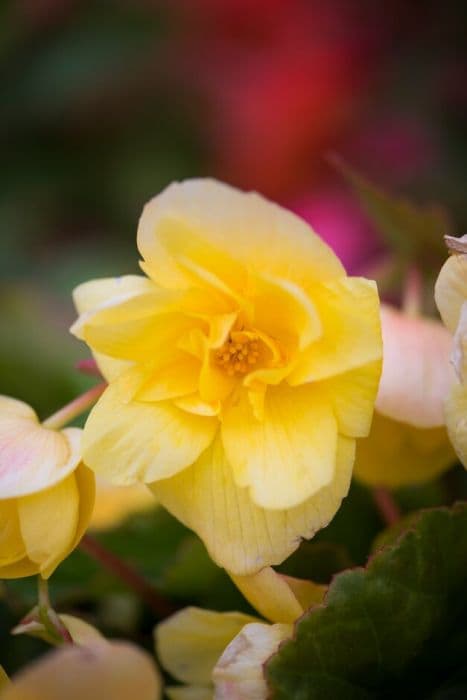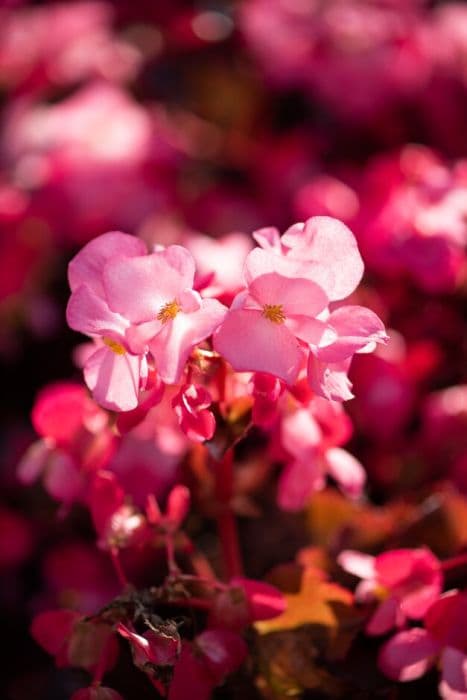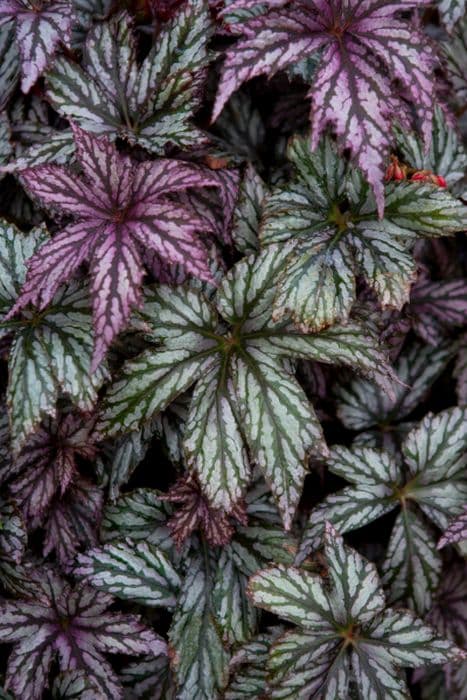Scarlet Begonia Begonia 'Panorama Scarlet'

ABOUT
The Begonia 'Panorama Scarlet' is distinguished by its lush, full foliage and vibrant scarlet blossoms that can add a splash of intense color to any garden setting. The leaves are typically a rich green, providing a beautiful contrast to the bright flowers. These blossoms have a generous, showy appearance, with delicate petals that create a sense of depth and texture. Their scarlet hue is rich and deep, drawing the eye and often making the plant a focal point wherever it is placed. Overall, the plant exudes a tropical feel, which is further accentuated by the dense arrangement of the leaves and the generous clustering of the blooms.
About this plant
 Names
NamesFamily
Begoniaceae
Synonyms
Scarlet Begonia, Panorama Scarlet Begonia
Common names
Begonia 'Panaura Scarlet'
 Toxicity
ToxicityTo humans
Begonias, including Begonia 'Panorama Scarlet', contain compounds that can be irritating to the skin and stomach if handled or ingested. If ingested, symptoms might include nausea, vomiting, salivation, and difficulty swallowing. Skin contact can cause irritation or rash.
To pets
For pets, Begonias are also considered toxic. Ingestion can lead to irritation of the mouth, tongue, and lips, excessive drooling, vomiting, and difficulty swallowing. It is important to keep pets away from Begonias to avoid these potential health issues.
 Characteristics
CharacteristicsLife cycle
Annuals
Foliage type
Deciduous
Color of leaves
Green
Flower color
Scarlet
Height
1-2 feet (30-60 cm)
Spread
1-2 feet (30-60 cm)
Plant type
Herb
Hardiness zones
10
Native area
South America
Benefits
 General Benefits
General Benefits- Vivid Coloration: The Begonia 'Panorama Scarlet' is known for its bright scarlet flowers which can add striking color to any garden or indoor setting.
- Continuous Blooming: This variety of Begonia is admired for its continuous and prolific blooming throughout the growing season, keeping gardens lively.
- Shade Tolerance: Begonias can thrive in a variety of light conditions, including shaded areas where other plants might struggle.
- Versatility: 'Panorama Scarlet' can be used in flower beds, borders, container gardens, and hanging baskets, offering flexibility in garden design.
- Attracts Pollinators: The flowers attract beneficial pollinators such as bees and butterflies, supporting the local ecosystem.
- Low Maintenance: This plant variety requires relatively low maintenance, making it a good choice for gardeners of all skill levels.
- Drought Tolerance: Once established, many Begonia varieties, including 'Panorama Scarlet,' exhibit a degree of drought tolerance.
- Fast Growth: Begonias typically have a rapid growth rate which allows for quick filling in of garden spaces or containers.
- Disease Resistance: 'Panorama Scarlet' Begonias are often resistant to many common plant diseases, minimizing the need for chemical treatments.
 Medical Properties
Medical PropertiesThis plant is not used for medical purposes.
 Air-purifying Qualities
Air-purifying QualitiesThis plant is not specifically known for air purifying qualities.
 Other Uses
Other Uses- As a natural dye: Begonia leaves can be boiled to extract a colorant for dyeing fabrics or paper.
- In terrariums: Their compact growth and vibrant flowers make begonias suitable for creating miniature landscapes indoors.
- As a subject for photography: The intense scarlet flowers of begonias can provide stunning, vivid subject matter for botanical photographers.
- Culinary garnish: Edible varieties of begonias can have their petals used as colorful garnishes for salads and desserts.
- As a teaching tool: Begonias can be used in educational settings to teach about plant biology and hybridization processes.
- Art and craft: Pressed begonia flowers can be used in creating botanical art, jewelry, or for decoration in scrapbooking.
- As a living gift: Rather than cut flowers, giving a potted begonia as a gift can provide long-lasting enjoyment.
- Biomimicry inspiration: The unique patterns of begonia flowers and leaves can inspire designs in textiles, wallpapers, and other artistic applications.
- Floral arrangements: Begonias can be used in flower arrangements to provide a splash of color and texture.
- Wedding décor: Begonias can be used to create vibrant table centerpieces or as part of bridal bouquets.
Interesting Facts
 Feng Shui
Feng ShuiThe Begonia is not used in Feng Shui practice.
 Zodiac Sign Compitability
Zodiac Sign CompitabilityThe Begonia is not used in astrology practice.
 Plant Symbolism
Plant Symbolism- Caution: Begonias, in general, can symbolize caution. They may be given to someone as a way to warn them of potential danger or to tread carefully in certain situations.
- Gratitude: They are also often associated with deep appreciation and gratitude. Gifting a begonia might be a way to thank someone meaningfully.
- Uniqueness: The distinct characteristics of Begonia 'Panorama Scarlet' might be seen as a symbol of someone's unique qualities and the celebration of individuality.
- Friendship: Begonias are commonly thought to represent friendship. They might be used to acknowledge a cherished friend or to celebrate a bond between companions.
- Harmony: The vibrant but balanced color of the 'Panorama Scarlet' variety might symbolize a sense of harmony and peace.
 Water
WaterScarlet Begonia prefers evenly moist soil and should be watered thoroughly when the top inch of soil feels dry to the touch. Generally, this might mean watering the plant with approximately 8-16 ounces of water every 4-7 days during active growth periods, depending on climate conditions. Be cautious not to overwater, as standing water or soggy soil can lead to root rot. During winter months, reduce watering to every 10-14 days, allowing the topsoil to dry out slightly more between waterings. Always use room-temperature water to avoid shocking the plant's roots.
 Light
LightScarlet Begonia thrives in bright, indirect sunlight and should be positioned in a spot where it can receive this light exposure without being subjected to harsh direct sun, which can scorch its leaves. An east-facing window that provides a soft morning sunlight or a north-facing window that offers consistent indirect light is ideal for the health and growth of the plant.
 Temperature
TemperatureScarlet Begonia prefers a moderate temperature range, thriving best between 60 to 75 degrees Fahrenheit. It can tolerate a minimum temperature of 50 degrees Fahrenheit but should be protected from drafts and sudden temperature changes. Maintaining a stable environment within its optimum temperature range will ensure the Begonia grows healthy and strong.
 Pruning
PruningPruning Scarlet Begonia is necessary to maintain its shape, encourage bushier growth, and remove any dead or diseased foliage. Prune the plant lightly in the spring or early summer to promote new growth and again as needed throughout the growing season to remove any unsightly or overgrown branches. The best time for major pruning is in the spring before new growth begins.
 Cleaning
CleaningAs needed
 Soil
SoilThe best soil mix for the Panorama Scarlet Begonia is a well-draining potting mix with added peat and perlite or sand to ensure proper drainage. A slightly acidic to neutral pH of 5.5 to 6.5 is ideal for this plant.
 Repotting
RepottingPanorama Scarlet Begonias should generally be repotted every 1-2 years, or when the plant outgrows its current pot or the soil appears exhausted.
 Humidity & Misting
Humidity & MistingPanorama Scarlet Begonias thrive in moderate to high humidity levels, between 50-70%. Avoid extremely dry environments.
 Suitable locations
Suitable locationsIndoor
Place in bright, indirect light and keep soil moist.
Outdoor
Partial shade; protect from hot afternoon sun.
Hardiness zone
10-11 USDA
 Life cycle
Life cycleThe life of Begonia 'Panorama Scarlet', also known as Scarlet Begonia, begins with seed germination, where warmth and moisture trigger the emergence of the seedling. After a few weeks, the seedling develops into a young plant with a set of true leaves, signaling the vegetative growth phase where the plant focuses on leaf production and root development. As the plant matures, it enters the flowering stage, typically in the warmer months, where it produces vibrant scarlet flowers that attract pollinators and are a key ornamental feature. Following pollination, the flowers develop into seed capsules that eventually dry out and release seeds, completing the reproductive cycle. In regions with winter frost, Scarlet Begonia may die back and enter a dormant state, surviving as tubers or rhizomes underground to regrow the following spring. However, in climates without frost, the plant can continue to grow and may remain evergreen, skipping dormancy altogether.
 Propogation
PropogationPropogation time
Spring-Summer
Propogation: The Begonia 'Panorama Scarlet', commonly known as Scarlet Begonia, is best propagated through stem cuttings. This method is typically performed in the spring or early summer when the plant is actively growing. To propagate, a healthy stem cutting with a couple of leaves is taken, ideally about 3 to 4 inches long (approximately 7.6 to 10.2 centimeters). The cut end of the stem is allowed to dry for a couple of hours to form a callus, which helps prevent rot. The cutting is then inserted into a moist well-draining potting mix, ensuring that at least one node (the point on a stem where leaves emerge) is below the surface. The pot is then placed in a warm, bright location, avoiding direct sunlight, with a consistent temperature of about 70°F (21°C) to encourage rooting. High humidity and keeping the soil consistently moist (but not waterlogged) will further aid in the development of roots over the course of several weeks.



![Begonia [Bonfire]](/_next/image?url=https%3A%2F%2Fplants-admin.emdemapps.com%2Fimages%2Fplants%2F%2Fimages%2F604b6124363f0.png&w=640&q=75)


![Begonia [Devotion]](/_next/image?url=https%3A%2F%2Fplants-admin.emdemapps.com%2Fimages%2Fplants%2F%2Fimages%2F604b58183573b.png&w=640&q=75)


